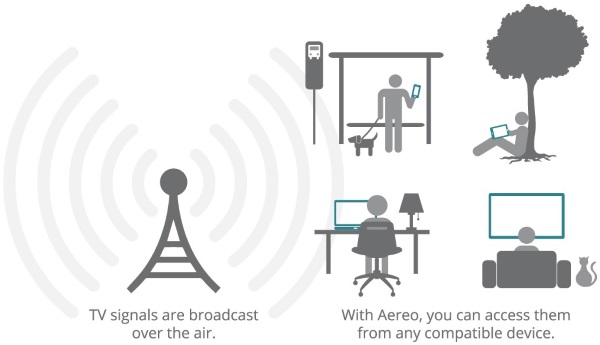Aereo’s Flaw was Hubris

The recent SCOTUS ruling making the service Aereo provides illegal was disappointing, but not surprising given the stakes. I was discussing this with a friend who pointed out that “The micro-antennas didn’t fool anyone, it’s the same as cable tv”. Which makes an incredibly valid point because it draws focus to what is the real problem with Aereo — hubris.
For those unfamiliar with Aereo, it is essentially a service where you can view over-the-air (OTA) TV (live and time shifted) over the Internet on a wide variety of devices. They did this by connecting vast arrays of micro-antennas to individually sand-boxed DVR in a data-center; essentially taking something that we all agree is legal (the OTA DVR), scaled it horizontally in a single, consolidated, location and then sprinkled a healthy helping of Cloud Dust on top to make it useful. When I look at this, as a technical person, it’s not hard to see the trees for what they are – discrete DVRs, placed closely together and connected to the Internet. So the question has to be asked how adding scale to a legal product could make it illegal, and I think the answer is that the implementation doesn’t matter, the technology doesn’t matter, the how it actually works doesn’t matter. The only thing that matters is how it looks. Free OTA TV on one end, paying users on the other means Cable TV. Cable TV providers pay OTA networks when they do that, so Aereo should pay as well. We can safely ignore the other differences between Cable TV and Aereo because none of that affects how it looks.
Aereo built their business on the clearly flawed idea that the implementation would matter. So they set out to purposely design an incredibly inefficient mechanism to link a single antenna with a single user, ensuring that content is stored and provided discretely. If that had worked, it wouldn’t take much to envision a world where Cable TV providers could use similar workarounds to cut out rebroadcasting fees to the OTA networks if the numbers worked. Challenging an entrenched business model important to a powerful group is risky, Aereo paid the price. That’s hubris.

great blog andrew. I was
great blog andrew. I was curious to their business model as well, and honestly the ruling doesn’t surprise me. It sucks for people in areas where they can’t get OTA for free…but then again and to the point of the courts, that’s why Cable Companies and Satellite Companies were created.
BUT…playing devil’s advocate…how many people are really PAYING cable providers for the basic channels one gets over OTA? If anything, increasing the reach for users who wouldn’t be paying for those basic could increase ad revenues, no? Maybe? Maybe i just like being argumentative
wayner wrote:
You should
[quote=wayner]
You should have the option of NOT paying for OTA channels with your cable sub since these channels are easily available for free. I really think the SCOTUS doesn’t totally understand the issues here. I don’t see how Aereo is a public performance while Slingbox isn’t. Or maybe the man will go after Sling next?
As Dr Johnny Fever said – don’t mess with the phone cops.
[/quote]
I think the distinction that was made was that Aereo was a centrally located center just as a CTV broadcast center, and was charging for OTA programing just as CTV providers do. But, Aereo was not paying licensing fees to the OTA broadcasters like CTV providers do.
Now I am not agreeing with SCOTUS’s decision (or much of anything that goes on in DC) but I see this as OTA broadcasters wanting to insure a revenue stream.
As I understand the evolution of Cable TV, it originally started in rural communities that had a difficult time receiving OTA broadcasts. So, the communities paid to put up a tall tower with an antenna array, paid to wire the community up, and paid someone to maintain the system for them. The OTA broadcasters were actually happy to have more viewers watching the commercials the were being paid to broadcast. Then Cable TV evolved. It spread to the urban communities and started adding networks that were not available on OTA broadcasts. These started to cut into the OTA broadcasters viewership and therefor their ratings and thus their revenue stream. I remember local news stories, from the late 80’s and early 90’s, of local cable companies having to remove OTA channels from their lineup until they negotiated a licensing deal with the particular broadcaster, and then cable rates started to skyrocket.
It’s all about who gets the little guys almighty $$$ and the little guy will never be able to keep theirs.
Dr Johnny Fever was quite right, Don’t mess with the incumbent industry.